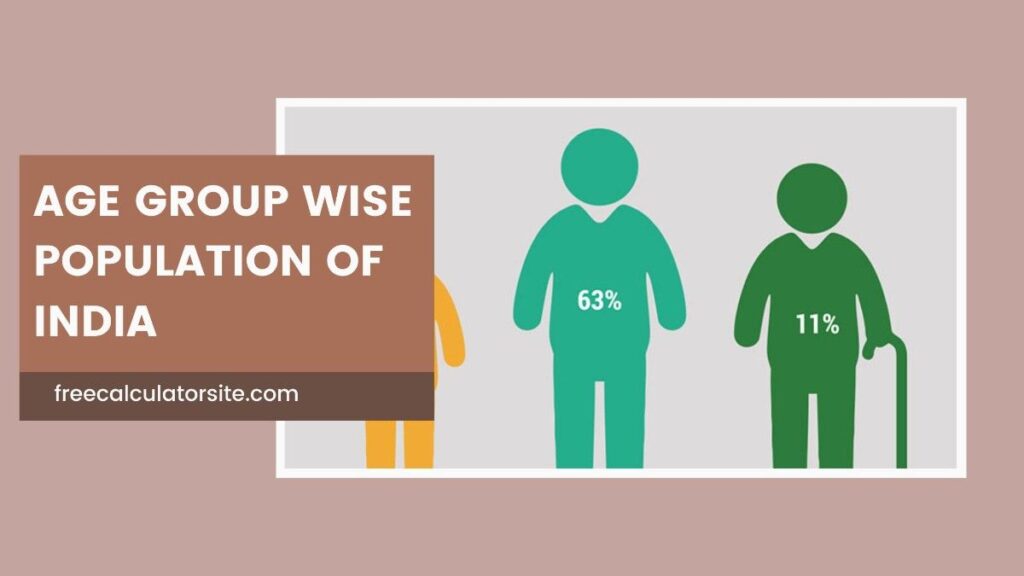Last updated on October 10th, 2024 at 07:26 pm

India, the world’s most populous country as of 2023, boasts a vast and diverse demographic landscape.
The distribution of the population across different age groups holds immense significance for policy planning, economic strategy, and social development.
Understanding these patterns offers insight into the country’s present and future challenges and opportunities.
This article delves into the age group-wise population of India, highlighting the socio-economic implications of each segment.
A Nation of Youth: India’s Young Population
One of the most prominent features of India’s population is its youth.
India has a large proportion of individuals below the age of 25, with the country often referred to as having a “demographic dividend”—a unique advantage where the working-age population is significantly larger than the dependent age groups.
As per the latest data:
- 0-14 years: This age group makes up around 25-30% of the total population. It includes infants, school-going children, and adolescents. The significance of this group lies in shaping the future of India. These young individuals represent future workers, innovators, and leaders. Investments in health, education, and skills development for this group are critical for maximizing their potential and ensuring the country’s growth.
- 15-24 years: India has one of the largest populations of youth globally, with approximately 20% of the population falling within this age bracket. This group, which includes teenagers and young adults, forms the backbone of India’s labor force in the coming years. The aspirations of this generation are evolving, with many moving towards urban centers in search of education and employment opportunities. The high percentage of young adults signifies a nation at a critical juncture in terms of economic productivity and innovation.
See Also: Height Weight Chart According To Age
The Working-Age Population: India’s Economic Engine
The working-age population is the driving force behind the economy.
Comprising individuals aged 25-59, this group is the most economically productive segment.
- 25-39 years: Approximately 20% of India’s population falls within this age group. These are individuals in the early to mid-stages of their careers, typically working in various sectors, including IT, manufacturing, and services. They are also the prime age group for starting families, which has implications for housing, healthcare, and consumption patterns. Many of these individuals are first-time homebuyers and contribute to the growth of sectors such as real estate, retail, and banking.
- 40-59 years: Roughly 15-17% of the population belongs to this age bracket. Individuals in this group are generally more experienced and hold key managerial or senior positions in their respective industries. As they are at the peak of their earning potential, their spending power drives consumer demand in various markets, from luxury goods to education for their children. Moreover, this group is responsible for significant tax contributions, supporting government expenditure on infrastructure, health, and welfare schemes.
The Elderly Population: A Growing Concern
India’s elderly population, those aged 60 and above, is increasing rapidly due to advancements in healthcare and improvements in living standards.
Although still a smaller percentage of the overall population, the senior citizens’ demographic is projected to grow considerably in the coming decades.
- 60+ years: This age group currently represents around 10% of the population. However, the numbers are expected to swell due to a decreasing fertility rate and increased life expectancy. The rapid growth of this age group presents challenges such as the need for a robust healthcare system, old-age security schemes, and social support. With the traditional family support system slowly weakening in urban centers, the demand for retirement homes, healthcare services, and social security will likely increase.
India’s Demographic Pyramid: A Shift in Structure
India’s demographic pyramid, which traditionally had a broad base (indicating a high number of young people) and a narrow top (fewer elderly individuals), is gradually transforming.
The base is narrowing due to declining birth rates, while the top is expanding as more people live longer.
This shift presents both opportunities and challenges:
- Opportunities: The growing working-age population can provide India with a significant economic advantage if they are properly skilled, educated, and employed. With a large youth demographic, India can become a global powerhouse in innovation, technology, and production. The government’s focus on schemes like ‘Make in India’ and ‘Digital India’ aims to leverage this young population for economic growth.
- Challenges: On the other hand, a rapidly aging population will strain public resources, especially healthcare and pension systems. India must prepare for the consequences of an aging society by strengthening its healthcare infrastructure and creating social safety nets for the elderly.
Rural vs. Urban Divide in Age Distribution
India’s population distribution also varies significantly between rural and urban areas, impacting how different age groups interact with the economy and society.
- Rural Areas: Nearly 65% of India’s population lives in rural regions. The age group distribution here is skewed towards the younger generation, as many working-age adults migrate to cities in search of employment. Rural areas have a higher dependency ratio, with a larger proportion of children and elderly. The youth in rural areas often lack access to quality education and healthcare, limiting their opportunities for growth and development.
- Urban Areas: Urban centers are characterized by a more diverse age distribution, with a higher concentration of working-age adults. These areas offer better job opportunities, educational institutions, and healthcare facilities, attracting migration from rural areas. However, urbanization has also led to challenges like overcrowding, housing shortages, and infrastructure strain.
Also Read: What is Chronological Age in IQ?
Implications for India’s Future
India’s age group distribution holds significant implications for its future, particularly in areas such as economic growth, social services, and infrastructure development.
Policymakers need to focus on:
- Education and Skill Development: The large proportion of youth demands significant investment in education and skill development. By equipping young individuals with the skills needed for modern industries, India can unlock its demographic dividend and maintain its competitive edge in the global economy.
- Employment Generation: With millions of young people entering the job market each year, creating employment opportunities is crucial. Fostering entrepreneurship, expanding industrial capacity, and promoting sectors like IT, manufacturing, and green energy will help absorb this growing workforce.
- Healthcare and Social Security: The rising elderly population calls for enhanced healthcare services and social security schemes. This includes improving geriatric care, expanding health insurance coverage, and creating pension schemes that provide financial security to the aging population.
Conclusion
India’s population is a dynamic and complex entity, with each age group presenting its own set of opportunities and challenges.
As the country continues to evolve, understanding the age group-wise population distribution will be key to crafting policies that ensure sustainable growth, social welfare, and economic development.
By tapping into the potential of its youth and addressing the needs of its elderly, India can chart a prosperous course for its future.

Akash Singh is a finance enthusiast who shares valuable insights on various calculators.
